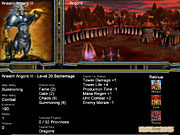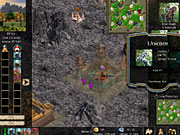Warlords IV: Heroes of Etheria Preview
The latest Warlords game updates the series' distinct brand of fantasy-themed turn-based strategy. We have hands-on impressions.
It may have been the Heroes of Might and Magic games that popularized fantasy turn-based strategy games and spawned other strong series like Disciples and Age of Wonders. But at the start of it all was Warlords, a 1990 game from Australian developer SSG--a game whose strategic gameplay more closely resembled a board game set in a fantasy world, rather than the combination of role-playing and strategy that other games in the genre have settled into. The Warlords series has since matured, producing a handful of turn-based sequels and two real-time strategy spin-offs in the Warlords Battlecry games. But in some ways, the upcoming fourth game marks a partial return to the series' roots, combining the fast, abstracted combat of the early games with the persistent heroes introduced in Battlecry.

Warlords IV features a full campaign, but the hero, or "warlord," you develop in the story-based scenarios can just as easily be used in skirmish or multiplayer battles. As you'll learn from the lengthy intro cinematics that precede the initial scenarios, the world of Etheria is again threatened by forces much more powerful than the world's myriad factions, which in turn always seem to be involved in some petty war with each other. Millennia have past since an event known as "The Sundering," when the dark elf prince Mordaine cast a great magic spell attempting to bring the world under his control, but instead nearly destroyed it. New forces are at work to replicate Mordaine's spell, but without the fatal flaw. The scenarios start you out slowly--the first only requires you to gather support by capturing neutral cities and then march north to defeat some invading orcs. But you'll find many, many scenarios ahead, as the world of Etheria is divided up into lots of different territories that you can capture, some of which are a part of the story, and some of which should be captured simply to get the bonuses they'll bestow on your warlord and his forces.
In the latest Warlords games, the persistent warlords really are persistent: Victories in both single-player and multiplayer games help build the character's abilities and the abilities of the three units that can follow along as a retinue. Creating a new warlord is a pretty simple process that requires you to choose major and minor abilities and a preferred faction and then customize your name and portrait. There are just six ability types--combat and the game's five major schools of sorcery (divine magic, rune magic, nature magic, summoning, and necromancy). It's possible to pick the same area of concentration for your major and minor abilities or mix them. But as you'll find out, the warlord is the last line of protection for your capital city, so if you go with a pure spellcaster, you'll need to have a sturdy garrison of troops.
The unusual thing about the game's hero system is that the warlords can't actually lead troops into battle. Instead, mercenary heroes, mythical creatures, and veteran units are recruited for this task. Fortunately, not only does the warlord gain experience from scenario victories, but every unit in the game can also gain experience and improve as a result of field battles. After some battles you'll simply be told that certain units have gained a level and be prompted to choose to improve the units' combat or life ratings or one of their special abilities. Though, while a basic foot soldier can gain levels and get appreciably better as a result, the basic units are not as likely to survive battles, so to fill out your army with high-level troops, you may have to explore ruins or recruit them with gold. But the experience system can make units that were good to begin with--like dragons, ogres, or minotaurs--even stronger if you risk them in battle.
Every battle in Warlords IV involves some risk. A conventional tactical combat system was planned for the game at the start of its development, but because of the game's scale and the frequency of combat, the combat was completely overhauled mid-development. The new combat is designed to be very fast, something that you'll appreciate in scenarios and multiplayer matches equally. When one of your war parties encounters an enemy group or city, the game changes to a side-view combat screen and you choose which unit to throw into battle first. That unit will fight away until it's dead or the first enemy is, and then each side puts a new unit into play. There's no retreat or any choice in how a unit fights once it's in battle, so rather than worry about tactical locations and target priorities, you'll instead want to think about how to mix groups of units and determine the order they should be used in. The process is quite reminiscent of a collectible-card game.

Putting an extremely powerful unit into combat is an all-or-nothing proposition, because a stream of weak soldiers can wear down a formidable hero. As a result, it's just as important to build lots of decent troops as it is to have a few elite units. This is where cities come into play. Most Warlords IV maps have a huge number of cities, from a few dozen in the game's smaller maps to 80 in the largest. At the start of a given scenario, both you and your computer opponents have one city each--the capital that can be captured to defeat a side--and the rest are neutral cities that are garrisoned with troops of varying difficulty but won't produce new units.
At the start of any map, you'll want to rush out and grab up as many neutral cities as you can, not only as a way to lay claim to more territory, but also to start a basic economy of unit production. There are 10 factions in the game, and each city can produce up to six of its faction's unit types. There are plenty of basic units that are functionally or even visually similar--the empire's cavalry units don't look very different from the knight faction's knight units--but since the game features a total of roughly 120 different units, you'll see some variety among your allies and enemies.
Warlords IV plays completely differently from Warlords Battlecry II, but the visual similarity is quite striking. The terrain engine for the scenario maps was adapted from the Battlecry II graphics engine. Nonetheless, the upcoming game seems to be a solid update to the Warlords series' brand of turn-based strategy, and it should offer many hours of single-player gameplay, as well as multiplayer features that benefit from the streamlined combat system. Warlords IV is scheduled for release this fall.
Got a news tip or want to contact us directly? Email news@gamespot.com
Join the conversation